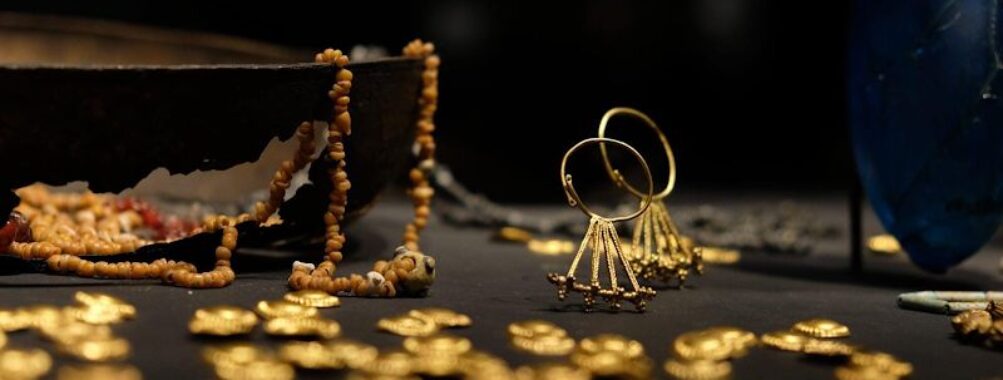
Georgian National Museum
“`html
Table of Contents
Description
The Georgian National Museum in Tbilisi is one of those places that quietly steals your attention. Housed in a stately 19th-century building, it’s more than just a museum—it’s a time capsule of Georgia’s long, layered history. From prehistoric fossils to glittering treasures of ancient kingdoms, it feels like the entire story of the country is tucked behind its grand doors. And honestly, it’s hard not to be impressed by how well it all comes together—science, art, archaeology, and culture blending into this immersive journey through time.
When you step inside, the air feels different—like it’s thick with stories. The exhibits are arranged thoughtfully, with dimly lit rooms guiding you through millennia of human evolution and civilization. The famous Gold of Colchis collection tends to draw the biggest crowds, and for good reason. Those delicate golden ornaments, crafted thousands of years ago, shimmer under the soft lighting like they were made yesterday. It’s one of those moments where you catch yourself leaning in, imagining the hands that made them.
What I love most about this museum, though, is how it manages to make history feel alive. There’s something deeply personal about walking past the skeletal remains of early humans discovered in Dmanisi—some of the oldest found outside Africa—and realizing that Georgia’s story is intertwined with the story of humanity itself. It’s humbling, in the best way.
The museum isn’t perfect—some rooms could use better lighting, and occasionally, the signage feels a bit sparse—but these are small details in the grand scheme of things. Most visitors leave with a sense of awe and a deeper appreciation for Georgia’s role in world history. The staff are friendly, the atmosphere is calm, and the entire experience feels respectful of the past while still very much alive in the present.
Key Features
- Extensive archaeological collections covering prehistoric to medieval Georgia
- Exhibition of the renowned Gold of Colchis artifacts
- Human fossils from Dmanisi—among the oldest in Eurasia
- Rotating exhibitions featuring Georgian and international art
- Accessible facilities including wheelchair-friendly entrances and restrooms
- Free Wi-Fi for visitors and a small café nearby for a post-tour coffee
- Family-friendly environment that keeps kids curious and engaged
- Educational programs and guided tours available in multiple languages
Best Time to Visit
If you’re planning your trip, weekdays are your best bet. Mornings tend to be quieter, giving you time to linger by the exhibits without feeling rushed. Spring and autumn are particularly pleasant times to visit Tbilisi in general—the weather is mild, and walking to the museum along Rustaveli Avenue feels like part of the experience.
During summer, it can get busier, especially with tour groups, but the museum’s air-conditioned halls make it a welcome escape from the city heat. Winter visits have their own charm too; fewer crowds mean you can take your time, maybe even sit in front of a favorite display just to soak it all in. I once spent nearly half an hour staring at a single gold pendant—it’s that kind of place.
How to Get There
Reaching the Georgian National Museum is straightforward since it’s located right in Tbilisi’s cultural heart. You can easily walk there if you’re staying near the city center. Most major bus routes and the metro stop nearby, and taxis are plentiful and affordable. If you’re the type who enjoys wandering, I’d recommend strolling down Rustaveli Avenue—it’s lined with theaters, cafés, and bookshops, making the journey almost as enjoyable as the destination itself.
For those who prefer convenience, ride-hailing apps work well in Tbilisi and will drop you right at the museum’s entrance. Parking can be tricky during peak hours, so public transport might save you some stress. And honestly, walking gives you a better feel for the city anyway.
Tips for Visiting
Here’s a bit of advice from someone who’s been there a few times: don’t rush it. The museum deserves at least two hours, maybe more if you’re the kind of traveler who likes to read every plaque and study every artifact (guilty as charged). Bring a bottle of water, wear comfortable shoes, and take breaks between floors—the building itself is spacious, and there’s a lot to see.
Photography is allowed in most sections, but flash is usually prohibited, so check the signs before snapping away. If you’re visiting with kids, the museum does a great job of keeping them entertained—there are interactive displays and plenty of visual exhibits that spark curiosity. And if you’re a history buff, consider joining one of the guided tours; the guides are passionate and often share stories that you won’t find written anywhere.
Accessibility is well thought out, with ramps and elevators for visitors with mobility needs. The restrooms are clean, and the Wi-Fi actually works (a small but pleasant surprise). There’s no on-site restaurant, but plenty of good cafés are just a short walk away. I’d suggest grabbing a coffee afterward and sitting outside to process everything you’ve just seen—it’s that kind of experience that lingers.
One last thing: take your time in the prehistoric section. It’s easy to breeze past the fossils and bones, but when you stop and think about their age—millions of years—it’s mind-blowing. It’s not just Georgian history you’re witnessing; it’s human history in its rawest form. And that realization alone makes the Georgian National Museum worth every minute you spend there.
Whether you’re a first-time visitor to Tbilisi or someone who’s been exploring Georgia for years, this museum is a must-see. It’s not flashy or overly modern, but that’s part of its charm. It tells the story of a nation that’s endured, evolved, and thrived—and somehow, you walk out feeling like you’ve been part of that story too.
“`
Location
Places to Stay Near Georgian National Museum
Find and Book a Tour
Explore More Travel Guides
No reviews found! Be the first to review!